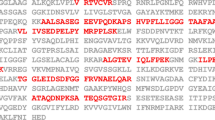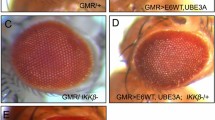Abstract
DNA damage, such as that elicited by UV-B, can induce either a cell cycle arrest or apoptosis that can be signalled by the p53 protein through the activation of a number of downstream cellular target genes. In contrast to oncogenic anogenital human papillomaviruses (HPVs), which mediate proteolytic degradation of p53, the E6 protein of cutaneous HPVs, such as HPV 77, do not promote p53 degradation. We have previously shown, however, that expression of HPV 77 E6 can effectively block UV-induced apoptosis in cells that have UV-activated p53. Here, we report that expression of the E6 protein from the cutaneous HPV 77 attenuates the UV-induced transactivation of p53-regulated proapoptotic genes Fas, PUMAβ, Apaf-1, PIG3. This inhibition of p53-activation of proapoptotic genes by HPV77 E6 is exerted selectively, as the increased expression of p53 target genes involved in cell cycle arrest or regulatory functions regulation, such as p21 and Hdm2, is unaffected. Our data suggest that HPV 77 E6 may play an important role in specifically deregulating p53-dependent transactivation of proapoptotic genes upon UV-B irradiation.
This is a preview of subscription content, access via your institution
Access options
Subscribe to this journal
Receive 50 print issues and online access
$259.00 per year
only $5.18 per issue
Buy this article
- Purchase on Springer Link
- Instant access to full article PDF
Prices may be subject to local taxes which are calculated during checkout





Similar content being viewed by others
Change history
21 June 2023
This article has been retracted. Please see the Retraction Notice for more detail: https://doi.org/10.1038/s41388-023-02755-x
References
Appella E and Anderson CW . (2001). Eur. J. Biochem., 268, 2764–2772.
Campomenosi P, Monti P, Aprile A, Abbondandolo A, Frebourg T, Gold B, Crook T, Inga A, Resnick MA, Iggo R and Fronza G . (2001). Oncogene, 20, 3573–3579.
Delius H, Saegling B, Bergmann K, Shamanin V and de Villiers EM . (1998). Virology, 240, 359–365.
de Villiers EM, Ruhland A and Sekaric P . (1999). Semin. Cancer Biol., 9, 413–422.
Harwood CA, Surentheran T, McGregor JM, Spink PJ, Leigh IM, Breuer J and Proby CM . (2000). J. Med. Virol., 61, 289–297.
Haupt Y, Maya R, Kazaz A and Oren M . (1997). Nature, 387, 296–299.
Jackson S, Harwood C, Thomas M, Banks L and Storey A . (2000). Genes Dev., 14, 3065–3073.
Jackson S and Storey A . (2000). Oncogene, 19, 592–598.
Kubbutat MH, Jones SN and Vousden KH . (1997). Nature, 387, 299–303.
Levine AJ . (1997). Cell, 88, 323–331.
Ludwig RL, Bates S and Vousden KH . (1996). Mol. Cell. Biol., 16, 4952–4960.
Malanchi I, Caldeira S, Krutzfeldt M, Giarre M, Alunni-Fabbroni M and Tommasino M . (2002). Oncogene, 21, 5665–5672.
Mantovani F and Banks L . (2001). Oncogene, 20, 7874–7887.
Nakano K and Vousden KH . (2001). Mol. Cell, 7, 683–694.
Oda E, Ohki R, Murasawa H, Nemoto J, Shibue T, Yamashita T, Tokino T, Taniguchi T and Tanaka N . (2000). Science, 288, 1053–1058.
Orth G . (1986). Ciba Found Symp., 120, 157–174.
Orth G, Favre M, Majewski S and Jablonska S . (2001). J. Virol., 75, 4952–4953.
Pluquet O and Hainaut P . (2001). Cancer Lett., 174, 1–15.
Polyak K, Xia Y, Zweier JL, Kinzler KW and Vogelstein B . (1997). Nature, 389, 300–305.
Purdie KJ, Pennington J, Proby CM, Khalaf S, de Villiers EM, Leigh IM and Storey A . (1999). EMBO J., 18, 5359–5369.
Rapp B, Pawellek A, Kraetzer F, Schaefer M, May C, Purdie K, Grassmann K and Iftner T . (1997). J. Virol., 71, 6956–6966.
Rowan S, Ludwig RL, Haupt Y, Bates S, Lu X, Oren M and Vousden KH . (1996). EMBO J., 15, 827–838.
Samuels-Lev Y, O'Connor DJ, Bergamaschi D, Trigiante G, Hsieh JK, Zhong S, Campargue I, Naumovski L, Crook T and Lu X . (2001). Mol. Cell, 8, 781–794.
Scolnick DM, Chehab NH, Stavridi ES, Lien MC, Caruso L, Moran E, Berger SL and Halazonetis TD . (1997). Cancer Res., 57, 3693–3696.
Sesto A, Navarro M, Burslem F and Jorcano JL . (2002). Proc. Natl. Acad. Sci. USA, 99, 2965–2970.
Steger G and Pfister H . (1992). Arch. Virol., 125, 355–360.
Storey A . (2002). Trends Mol. Med., 8, 417–421.
Storey A, Massimi P, Dawson K and Banks L . (1995). Oncogene, 11, 653–661.
Surentheran T, Harwood CA, Spink PJ, Sinclair AL, Leigh IM, Proby CM, McGregor JM and Breuer J . (1998). J. Clin. Pathol., 51, 606–610.
Vousden KH . (2002). Biochim. Biophys. Acta, 1602, 47–59.
Wattre P, Bert V and Hober D . (1996). Ann. Biol. Clin. (Paris), 54, 189–197.
Yu J, Zhang L, Hwang PM, Kinzler KW and Vogelstein B . (2001). Mol. Cell, 7, 673–682.
Acknowledgements
We thank B Vogelstein for the kind gift of the PIG3 promoter reporter plasmid. This research was supported by Cancer Research UK and a Marie Curie postdoctoral fellowship to RG-E.
Author information
Authors and Affiliations
Corresponding author
About this article
Cite this article
Giampieri, S., García-Escudero, R., Green, J. et al. RETRACTED ARTICLE: Human papillomavirus type 77 E6 protein selectively inhibits p53-dependent transcription of proapoptotic genes following UV-B irradiation. Oncogene 23, 5864–5870 (2004). https://doi.org/10.1038/sj.onc.1207711
Received:
Revised:
Accepted:
Published:
Issue Date:
DOI: https://doi.org/10.1038/sj.onc.1207711



